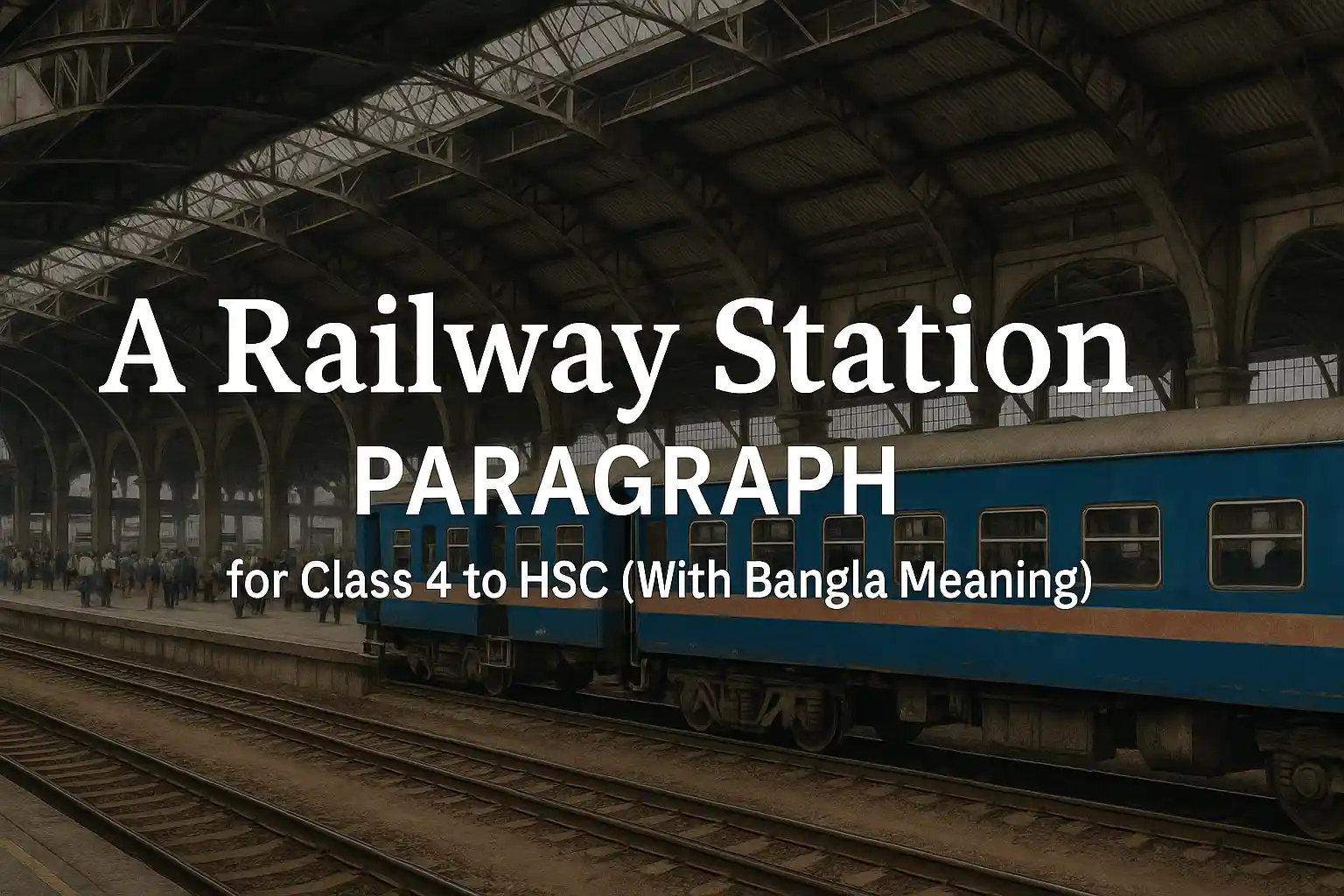A Railway Station Paragraph for Class 4 to HSC (Bangla Meaning)
A railway station is a common topic in exams and everyday learning. It connects people, places, and stories.
In these paragraphs, you will find clear and simple ideas about a railway station. It is written to help students understand the topic easily and use it in class tests and important exams.
In this paragraph, we’ve tried to cover the following questions.
- What is a railway station?
- Where is it usually located?
- What can be seen at a railway station?
- How does it help passengers?
- What services are available there?
- How busy is a railway station?
- What types of people visit it?
- What are the common scenes there?
Paragraph on A Railway Station With Bangla Meaning (100 Words)
A railway station is a place where trains stop to pick up and drop off passengers. It is usually built in towns or near busy areas. People come here to travel long and short distances.
At a station, we see ticket counters, waiting rooms, food stalls, and porters carrying luggage. Announcements tell passengers when a train will arrive or leave. Some stations are very crowded and always full of noise.
Many people like students, job holders, and village people use trains every day. A railway station shows a picture of a busy life. It plays an important role in our daily travels.
A Railway Station Paragraph for Class 6-7 (150 Words)
A railway station is a place where trains stop to take and drop passengers. It is usually found in cities, towns, and even in some large villages. People come here to travel to near and far places.
At a railway station, we see platforms, ticket counters, waiting rooms, tea stalls, and loudspeakers for announcements. There are benches for sitting, clocks to show time, and digital boards to show train schedules. Porters carry luggage, and hawkers walk around selling snacks, toys, and water.
It helps passengers by giving them a safe place to wait and board trains. Security guards are there to keep everything safe. Some stations even have toilets, bookshops, and prayer rooms.
A railway station is always busy and full of people. We see students, workers, businessmen, and even farmers. Everyone looks in a hurry when a train arrives or leaves. It shows the movement of life and plays an important role in public transport.
A Railway Station Paragraph for Class 8 (200 Words)
A railway station is a place where trains stop to pick up and drop off passengers. It is usually built in busy towns, cities, or important villages. Trains come and go on fixed schedules, and people wait there to travel long or short distances.
At a station, we see platforms, ticket counters, clocks, waiting rooms, and food stalls. There are loudspeakers that announce train arrivals and departures. Security guards, station staff, porters, and even hawkers are part of the daily scene.
Passengers buy tickets from counters or machines. Some stations now use digital boards and automated gates. Benches are placed for people to sit, and many stations have clean toilets and prayer rooms.
A railway station helps passengers in many ways. It gives them a place to rest, buy food, or get train updates. Medical help and lost-and-found services are also available in larger stations.
The station is always crowded. People of all ages and professions come here. Students, workers, travelers, and even farmers visit railway stations.
Common scenes include people saying goodbye, rushing to board, and porters carrying heavy loads. It is a place full of life and movement. The railway station is not just a travel point—it is a reflection of busy human life.
A Railway Station Paragraph for Class 9-10/ SSC (250 Words)
A railway station is a place where trains stop to pick up and drop off passengers. It is usually located in towns, cities, or near busy areas. In big cities, there may be more than one station to serve different routes.
A railway station is often full of life and movement. You can see passengers walking with bags, porters helping them, and hawkers selling tea and snacks. There are long platforms, ticket counters, waiting rooms, and electronic boards showing train times.
Railway stations help people travel quickly from one place to another. Students, workers, patients, and businessmen all use trains to reach their destinations. It saves time and is often cheaper than other transport.
Inside the station, there are many services. You will find ticket booths, food stalls, public toilets, and security guards. Bigger stations may have digital ticket machines, clean drinking water, and even Wi-Fi.
A railway station is always busy. From early morning to late night, people are coming and going. Some people wait for hours, while others rush to catch their trains.
Different types of people visit the station every day. Rich and poor, young and old—all come here. Some are happy to meet someone; others are sad to say goodbye.
Common scenes include the sound of announcements, the whistle of trains, and the crowd near the ticket counter. Though noisy, a railway station is a place full of stories and journeys.
A Railway Station Paragraph for HSC (300 Words)
A railway station is a place where trains stop to pick up and drop off passengers. It is a key part of our transport system. Most stations are located in towns, cities, or beside important roads so people can reach them easily.
At a railway station, many things happen at once. You will see platforms, ticket counters, waiting rooms, and signal lights. People line up for tickets while announcements are made through loudspeakers.
A railway station helps people travel long distances at low cost. Trains carry thousands of people every day. It is especially helpful for students, job holders, and patients who need to go to other cities.
There are many services at a station. You can buy tickets, food, and water. Some stations have bookstalls, prayer rooms, ATM booths, and free charging points.
A station is always full of activity. Some people are arriving; others are leaving. The platform becomes crowded when a train arrives.
Different kinds of people come here. Businessmen, travelers, daily workers, tourists, and even beggars are found at stations. You may also see vendors selling snacks, tea, fruits, and newspapers.
Common scenes include the loud sound of train whistles, people waving goodbye, and the voice of the announcer. The station master and guards are always alert to ensure safety. Cleaning staff work regularly to keep the station tidy.
Sometimes, trains get delayed and people wait for hours. But despite the noise and rush, a railway station plays a very important role in our daily life. It connects people and places. It is more than just a stop—it is a gateway to new journeys.






